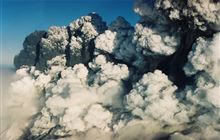Volcanic advisory modified for Ruapehu’s summit craters area
Archived content: This media release was accurate on the date of publication.
Introduction
DOC has reduced the area of caution around Ruapehu’s crater to 400 m from the Crater Lake shore.Date: 24 May 2016
DOC recommends people do not enter the crater basin area beyond Dome Ridge or low points on the active crater rim, or camp anywhere in the summit craters or in the upper parts of valleys draining the crater basin. This reduces the area of caution from 2 km (the Summit Hazard Zone) advised by DOC on 11 May 2016.
Normal operations continue for visitors to all areas outside the summit craters and upper valleys.
GNS Science issued a Volcanic Alert Bulletin on 11 May raising the Volcanic Alert Level from 1 to 2 (elevated volcanic unrest) due to heating of the Crater Lake and other associated indicators of increased volcanic unrest.
GNS Science has continued to monitor the volcano closely and on 17 May issued a second Bulletin noting early signs the heating might have peaked. Their ongoing monitoring has clarified some of the uncertainty about the unrest situation.
"The lake temperature has started to fall, although the gas emission and volcanic tremor remain elevated, so the Volcanic Alert Level for Mt Ruapehu remains at Level 2”, says Nico Fournier GNS Science Head of Volcanology.
“There is now less volcanic risk to climbers and others wanting to visit the upper part of the mountain,” concludes Dr Harry Keys, DOC’s Technical Advisor Volcanology.
“However, climbers and others visiting the summit area, should minimise their time in this area and in the upper parts of valleys on the mountain”, he says. “This includes the floors of the higher valleys draining the crater basin area.”
People away from the volcano are not affected and visitors are not being warned to stay away from the mountain. “The public at all three ski areas, roads and areas surrounding the mountain were not, and are not, affected by this advisory” says Paul Carr, Operations Manager for Tongariro National Park.
“We know Ruapehu continues to be one of the more unpredictable volcanoes, which is why we issue advisories when there is extra concern for public safety on the mountain” he said.
“Full winter conditions now exist on the mountain. People going above the parks’ road ends should be fully equipped with alpine clothing, crampons and ice axe, know how to use them and take account of the weather forecast ” he said.
The level of unrest at Mt Ruapehu is continually monitored by GNS Science through the GeoNet project. The aim is to ensure any changes in the volcanic state are detected at the earliest possible time and communicated to DOC and Ruapehu Alpine Lifts so appropriate procedures can be put in place.
Contact
Dr Harry Keys, DOC Technical Advisor Volcanology, Turangi
Phone: +64 7 376 2549
Mobile: +64 27 479 0550

